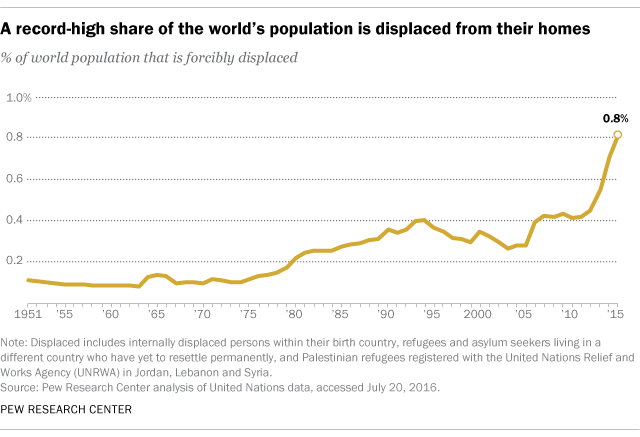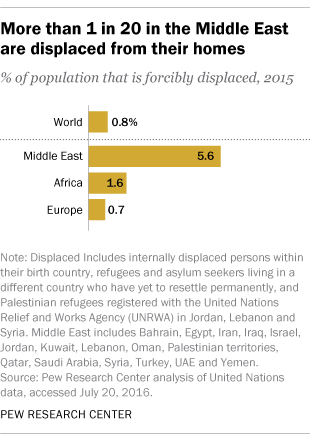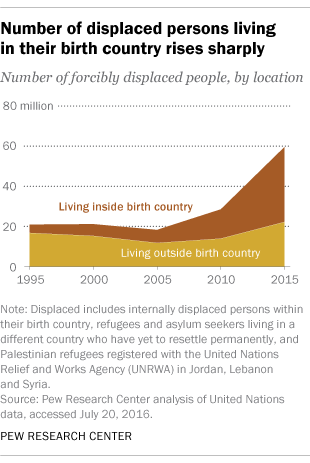
More than 60 million people are displaced from their homes as of the end of 2015, the highest number of displaced people since World War II, according to the United Nations High Commissioner for Refugees (UNHCR). This group accounts for 0.8% of the world’s population, or nearly 1 in 100 people globally, and represents the highest share of the world’s population that has been forcibly displaced since UNHCR began collecting data on displaced persons in 1951.
Recent years have seen a surge in the number of people forcibly displaced from their homes. A record number of asylum seekers arrived in Europe in 2015, with most coming from Syria, Iraq and Afghanistan. And nearly a million South Sudanese are believed to be on the move because of conflict in their country. Global efforts to address displacement are underway. In September, the United Nations will host a summit to discuss this trend and President Barack Obama will host a related meeting of world leaders.

The UNHCR defines displaced persons as those who have been forced to leave their homes. This includes those who still live in their country of birth (internally displaced persons) as well as those who left for a different country (refugees and asylum seekers) and have yet to resettle permanently. People can be displaced for years or, as is the case for Palestinian refugees, even for generations.
Displacement levels are higher in some regions of the world than others. More than one-in-twenty people living in the Middle East (5.6%) are displaced. Meanwhile, about one-in-sixty people living on the African continent (1.6%) are displaced (not including Egypt, which is considered part of the Middle East). In Europe, 0.7% of the population is displaced, similar to levels following the collapse of Eastern Bloc countries in the early 1990s.
Conflict in Syria has been the principal contributor to the recent growth in the world’s displaced population. Some 12.5 million Syrians have been displaced since the country’s civil war began in 2011, accounting for about one-in-five of all the world’s displaced people. In fact, the Syrian-born displaced population is the largest recorded for a single origin country in a given year.

Some countries have millions of displaced persons living within their borders. Among the top three countries are Colombia (6.9 million), Syria (6.6 million) and Iraq (4.7 million). Most of the displaced people living in these countries were born there and are considered internally displaced persons.
In other countries with large numbers of displaced persons, many are refugees from elsewhere. For example, Turkey has more than 2.5 million Syrian refugees as of the end of 2015, accounting for most of Turkey’s nearly 2.8 million displaced people. And Pakistan has more than 1.5 million refugees from Afghanistan, making up more than half of the 2.7 million displaced people living within Pakistan’s borders.
A growing share of the world’s displaced persons are displaced within the country of their birth. In 1995, 20% of all displaced persons were living inside their birth country. That share grew to 36% by 2005, 51% by 2010 and nearly two-thirds (63%) by 2015, when 37 million displaced people were living inside their birth country.
Meanwhile, about 22 million displaced people did not live in their birth country in 2015, a number that has grown in tandem with the size of the displaced population worldwide. These displaced people make up about 9% of the world’s 243 million international migrants – those moving across borders, regardless of their motivation for doing so (forced or not). (This share would drop to about 8% if registered Palestinian refugees living outside of the Palestinian territories in Jordan, Lebanon and Syria were not included in the number of displaced persons.) This share among international migrants is lower today than it was a quarter century ago. In 1990, 12% of the world’s international migrants were displaced persons, reflecting the large number of refugees resulting from the breakup of the former Soviet Union and Eastern bloc countries.
